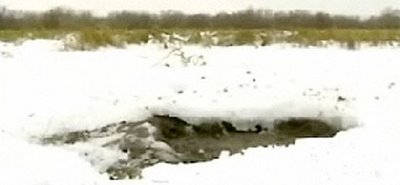
October 13, 2008
In conjunction with my recent posting, “Siberian Snowman Takes A Stroll,” below are photos of the tracks.


Credit: Grenz Wissenschaft-Aktuel
Once I lived in region of Salekhard for one month with a group of students and gathered there a couple of reports about wild men there/ It was many years ago.
Our researcher Vladimir Poushkaryov visited the neighbour regions in Eastern Europe and gathered there many reports about such creatures called Mirygdy by locals and in Northern Siberia (Yakutia, now Sakha) called Chuchunaa. He went to that region South of Salekhard in Autumn of 1978 and disappeared there.
Mecheny is a Russian word means “marked” – is the name of one individual – creature seen by researcher Maya Bykova (female) in Western Siberia, creature’s left hand was of white colour (seen on the drawing)that is why Maya called it “marked” (Mecheny). It is not a local name of such creatures.
The new footprints could be the real prints of a creature, but they are not so clear to say definitely whose they are.
Also I don’t understand why the hunter melted snow. Igor Bourtsev
The above Asian Siberian unknown hominoid, individually named Mecheny, as drawn by artist Harry Trumbore, appears in The Field Guide to Bigfoot and Other Mystery Primates.
No new reports so far but we are trying to contact witnesses there. The location is in Western Siberia were Vladimir Pushkarev conducted searchers in the 1970s, was lost and never found. The late Maya Bykova also did fieldwork in that general area in the 1980s, and sighted the homin nicknamed Mecheny (Marked), see “In the Footsteps of the Russian Snowman,” 1996, pp.123-50.
Not long ago I received a book, in Russian, by Olga Koshmanova, a Mansi by nationality (one of the Siberian indigenous ethnic peoples like your Native Americans), who cooperated with Maya Bykova. The book is titled “Looking at the Back” (no explanation of the title given), 160 pages, 2008. It’s a collection of local folk tales about the kompolen (Mansi name for the homin) and eyewitness accounts, with the author’s comments. The evidence is strikingly similar to all we know about sasquatch, as regards both the homins and the traditions and attitudes of the native people. Like with Native Americans regarding sasquatch, kompolen is seen as the lord of the forest and protector of wildlife. Paranormal beliefs connected with these beings are abundantly cited and emphasized. Actually, I wouldn’t know how to draw the line between the Siberian and North American homins.
One curious detail. Local hunters, before returning home, leave in their hunting log cabin in the forest some provisions and a kerosene lamp, to be used when they come hunting there next time. Once, according to the author, upon their return, the hunters discoverd that the kerosene lamp and the table on which it stood were missing from the cabin. They wondered who could take a table and kerosene lamp in the wilderness. Later they found the table in a swamp with the kerosene lamp standing intact on it.
Linda Coil-Suchy, in an interview to be published in her book next year, asked me in particular the following: “Can you tell us how Russian forestman differs from the north American sasquatch in relation to size, footprints, vocalization, and appearance? And do you believe they are of the same or a different species?”
I answered: Judging by available data, I don’t think our “forestman” Leshy is noticeably different from your “forestman” Bigfoot. I think that if they are different,then at the level of races, i.e., subspecies.
The latest news from Siberia seems to support my words.Dmitri Bayanov
About Loren Coleman
Loren Coleman is one of the world’s leading cryptozoologists, some say “the” leading living cryptozoologist. Certainly, he is acknowledged as the current living American researcher and writer who has most popularized cryptozoology in the late 20th and early 21st centuries.
Starting his fieldwork and investigations in 1960, after traveling and trekking extensively in pursuit of cryptozoological mysteries, Coleman began writing to share his experiences in 1969. An honorary member of Ivan T. Sanderson’s Society for the Investigation of the Unexplained in the 1970s, Coleman has been bestowed with similar honorary memberships of the North Idaho College Cryptozoology Club in 1983, and in subsequent years, that of the British Columbia Scientific Cryptozoology Club, CryptoSafari International, and other international organizations. He was also a Life Member and Benefactor of the International Society of Cryptozoology (now-defunct).
Loren Coleman’s daily blog, as a member of the Cryptomundo Team, served as an ongoing avenue of communication for the ever-growing body of cryptozoo news from 2005 through 2013. He returned as an infrequent contributor beginning Halloween week of 2015.
Coleman is the founder in 2003, and current director of the International Cryptozoology Museum in Portland, Maine.
Filed under Bigfoot, Breaking News, Cryptotourism, CryptoZoo News, Cryptozoologists, Cryptozoology, Footprint Evidence, Photos, Sasquatch, Yeti